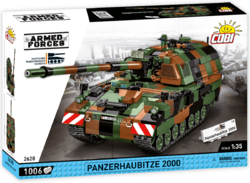
You know that:
- In the mid-1980s, the German army was looking for a suitable replacement for the aging American M109 Paladin.
- At first, an Italian-British-German association tried to develop the new machine, but the project was canceled due to high development costs.
- The plans were modified and the German company Krauss-Maffei developed the first 155 mm howitzer on the chassis of the Leopard 2 tank.
- In 1991, 4 prototypes were built, which had to undergo demanding tests. Tests were also conducted in extremely high and low temperature environments to verify that the PzP 2000 can be deployed anywhere in the world.
- The vehicle is able to start firing within 30 seconds of stopping.
- The automatic loading and ingenious MICMOS fire control system allows up to five projectiles on different ballistic trajectories to hit a single target.
- At the time the PzP 2000 machines were included in the armament, it was a weapon that had no competition in the world.
- The Bundeswehr took the first pieces into service in 1998.
- Current users are Germany, Italy, Greece, Netherlands, Croatia, Lithuania, Qatar, Hungary and Ukraine.
- 60 different types of ammunition were developed for the PzP 2000 howitzers.
- In total, more than 384 units were produced.
Technical parameters:
- dimensions: length 7.9 m, width 3.1 m, height 3.6 m
- weight 55,000 kg
- passive armor protection against projectiles up to 47 mm
- drive unit 8-cylinder diesel engine MTU 881 Ka-800 with a power of 736 kW
- maximum speed 67 km/h
- range 420 km
- main armament Rheinmetall 155/L52 cannon caliber 155 mm (ammunition stock 60 rounds)
- effective range, depending on the type of ammunition, up to 54 km
- secondary armament MG 3 machine gun caliber 7.62 mm
- crew 3 + 2 (only 3 possible for combat deployment)
Military mechanic about PzP 2000:
"The PzP 2000 operating regulations allow only 100 shots per day to keep the barrel temperature below 450 °C. One hundred shots is the top parameter."
Assembly instructions




